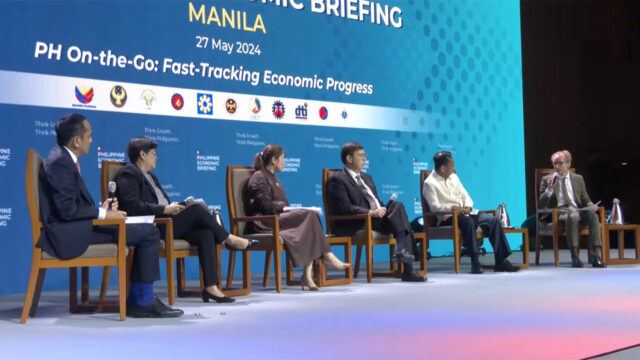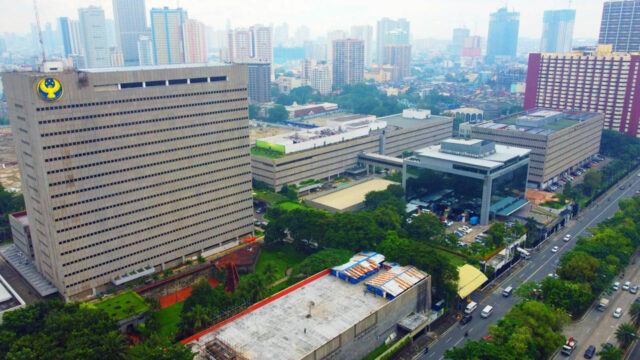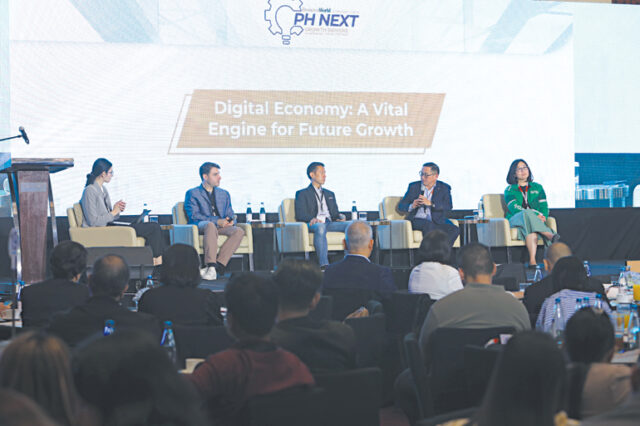IT IS OFFICIAL: The United Nations announced that the Paris Agreement’s long-term goal of limiting global warming to 1.5°C has not been met. Worse, this failure has been exacerbated by a triple planetary crisis of climate change, nature and biodiversity loss, and pollution. The impacts are particularly severe in the Asia Pacific region. Our survival now hinges on two major imperatives from the Paris Agreement: to radically and swiftly transform how we operate our economy and to ensure that these transitions are fair, inclusive, and just for everyone1.
In response to these challenges, the concept of a circular economy (CE), defined by the UN as “a sustainable system where resources are used efficiently and waste is reduced through a continuous cycle of reuse and regeneration”,2 has gained prominence in development policy and investment arenas. However, to ensure this new approach to economic planning is equitable, CE must address the concerns of the workforce likely to be disrupted during the transition.
The Asian Development Bank (ADB) is a major convenor and financier of poverty reduction, climate action, and circularity with a commitment to making transitions just for vulnerable sectors3 as a pillar of its operational strategy “to leave no one behind.” To date, however, its 2009 Safeguards Policy, designed to avoid and mitigate the negative impacts of its development projects, has yet to encompass the rights of the informal workers, constituting 1.3 billion persons or 65% of the world’s informally employed workforce4.
Resource conservation, particularly in developing countries, heavily depends on informal waste workers with waste pickers occupying the lowest and most impoverished rung of the waste value chain. Waste pickers are characterized as individuals who collect items and materials from public spaces, open dumpsites or landfills, and/or waste bags and bins on streets and sell the recyclables they find to traders. Often unsung heroes, they play a pivotal role in climate action by reintroducing used resources back into the economy for human consumption, despite enduring harsh working conditions, health risks, social stigma, harassment, low income, and limited access to social services. Most waste pickers in the Asia Pacific region hail from traditionally marginalized communities or minority groups.
Just how many of them are in the region to warrant attention? In India, nearly 3 million informal waste workers are responsible for recycling almost 20% of the country’s waste5. In Vietnam, these workers purchase 30% of waste in cities and carry out more than 90% of recycling activities6. Indonesia has around 3.7 million organized waste pickers, who, in Jakarta alone, contribute to the reduction of the volume of waste by 30%7. Hordes of informal waste workers appear in various studies: In China (6 million) 8, Thailand (1.5 million)9, and the Philippines (100,000)10 which are underestimated given the lack of government-led databases. A development bank without an agenda for this sector is massively failing millions of poor people in the transition.
Four types of ADB projects are harming informal waste workers. First, the unabated promotion and financing of fossil-based waste-burning technologies such as waste-to-energy (WtE) incinerators and Refuse-Derived Fuel (RDF). Financing these false solutions brazenly tagged as “zero emissions,” “clean energy,” or “recycling technologies,” not only steals the livelihoods of waste pickers but also stifles the potential for climate action. Instead of benefiting from high-value waste materials, waste pickers are sidelined, undermining the entire informal waste economy. ADB does not seem to learn from funding the Timarpur-Okhla Waste Management Plant which it eventually withdrew after communities protested the pollution coming from it in 2010. It continues to burn tons of Delhi’s recyclables, effectively wiping out emissions savings from approximately 962,133 tCO2e through the waste pickers’ recycling efforts.
ADB has not monitored the impacts of its support for WtE incinerators in Vietnam (Binh Duong11 and Can Tho12), Indonesia (Solo and South Tangerang), Thailand (Songkhla13), Malaysia14, China, Marshall Islands15, and the Maldives16. The Bank was also instrumental in creating profitable and risk-free operations for industry polluters in emerging markets through technical assistance projects. The TAs in Cambodia17, Indonesia18, and Bangladesh19 are all designed to deliver reports that end up justifying the deployment of WtE and RDF or to facilitate partnerships20 with WtE corporations, even in a country like the Philippines where legislated bans are in place. ADB supported one of the world’s leading plastic polluters, Procter & Gamble, in crafting feasibility studies for establishing WtE incinerators in Angeles21, Cabuyao22, and Dagupan23. In a world where global leaders are already tackling a treaty to address plastic pollution, ADB’s support for false solutions is extending the lifelines of polluters.
Second, waste infrastructure projects often require the closure of landfills or construction of new ones such as those funded by ADB in Cambodia24, Uzbekistan25, Mongolia, Myanmar26, and India27 which also poses harm to this sector. Contrary to safeguards appraisals claiming these projects only have “limited” involuntary resettlement and “temporary” economic impacts, waste pickers face permanent losses in income and social services when displaced. Whether it is the state or a corporation, project proponents often flag occupational hazards for outlawing the access of waste pickers, thereby gaining monopoly ownership to the city’s waste. Waste pickers are then exposed to bribery, harassment, and violence just to regain access.
Compensation schemes for the displacement of waste pickers in landfill closures also exploit the systemic structures that cause their poverty. In the Bank’s project in Myanmar, child waste pickers were not paid for loss of income from forcible resettlement as a result of the landfill closure because they are children while the adults were given entitlements. Waste pickers were also not compensated for their loss of homes as they did not own official land titles.
Third, large-scale privatized recycling projects without integrating the participation of the sector are also pernicious. Recycling is often thought to yield only positive results but with new policies incentivizing initiatives for recycling, businesses saw a lucrative field in competition with the existing informal waste sector. The $300 million loan for Indorama Ventures28 in Thailand aimed at directly recycling 50 billion plastic bottles until 2025 did not assess the potential economic displacement of waste pickers, on top of the environmental breaches of the two recycling plants which include the presence of around 120 hazardous chemicals, fires, spillage, impacts on workers’ health, and absence of community engagement. Privatized recycling projects only target high-value materials, like PET bottles or cardboard, reducing waste pickers’ incomes and leaving behind an unsustainable value chain of only low-value recyclables, which will eventually collapse as seen in developed economies.
Fourth, the introduction of waste collection models that are exclusionary of the existing systems that waste pickers have built. The ADB has been hailing the use of digital technologies in the collection and sorting of plastic waste as “modernizing,” “efficient,” and “innovative”29 — without fully assessing how the new collection system can either assist or displace the vulnerable sections in the waste value chain.
From seeing the role of the informal workers in the waste sector and the harms they face to consulting them meaningfully in the development of policies, projects, and roadmaps — the sector has been missing and neglected in the Bank’s agenda.
The ADB has the opportunity to improve millions of lives through the ongoing revision of its safeguards policy30 by finally recognizing the fundamental human dignity and protecting the rights of informal workers as leading agents in the circular economy. The ILO Recommendations 193, 204, and 20531 guide member-states on ensuring a just transition. Sustainable and inclusive waste management systems established by waste pickers in Vietnam, the Philippines, India, etc. can provide insight on operational mechanisms for ensuring such a just transition.
We highly recommend the proactive creation of consultation spaces for the informal waste sector in the formulation of the Bank’s policies, programs, projects, and investment roadmaps in pursuit of hearing the voices of those who are at great risk of being left behind.
Finally, the ADB should complement these efforts by committing to a phase-out from false solutions and directly investing in upgrading and protecting livelihoods within the informal waste economy. The ADB must shift its financing to transformative and equitable climate solutions, embracing zero waste alternatives.
(The authors are part of GAIA, a network of grassroots groups as well as national and regional alliances representing more than 1,000 organizations from 92 countries. GAIA envisions a just, zero waste world built on respect for ecological limits and community rights, where people are free from the burden of toxic pollution, and resources are sustainably conserved, not burned or dumped.)
Mayang Azurin is GAIA Asia Pacific’s Deputy Director for Campaigns. Harshad Barde is the Informal Recycling Sector & Plastic Waste Management Director of the SWaCH Pune Cooperative, India’s first autonomous cooperative of informal waste-pickers. Contact the authors through miriam@no-burn.org and harshadbarde@gmail.com
1 https://climatepromise.undp.org/news-and-stories/what-just-transition-and-why-it-important
2 https://www.undp.org/philippines/blog/ce-inclusivity-empowering-informal-waste-workers-sustainable-future-international-human-solidarity-day
3 https://www.adb.org/news/adb-joins-mdbs-support-just-transition-toward-net-zero-economies
4 https://www.ilo.org/asia/media-centre/news/WCMS_627585/lang–en/index.htm#:~:text=population%20in%20…-,More%20than%2068%20per%20cent%20of%20the%20employed%20population%20in,work%20and%20decent%20working%20conditions.
5 https://sprf.in/informal-waste-workers-the-issue-of-formalisation/
6 https://earthjournalism.net/stories/meet-vietnams-waste-warriors
7 https://journals.sagepub.com/doi/full/10.1177/0734242X231199938
8 https://www.ncbi.nlm.nih.gov/pmc/articles/PMC10693742/
9 https://www.bangkokpost.com/opinion/opinion/1984063/plastic-waste-still-an-issue
10 https://www.no-burn.org/igniting-change-waste-workers-in-the-philippines-unite-for-rights-and-recognition/#:~:text=Various%20estimates%20place%20the%20number,this%20is%20a%20gross%20underestimation.
11 https://www.no-burn.org/urging-the-adb-to-withdraw-proposed-financing-for-waste-to-energy-incineration-in-viet-nam/
12 https://www.adb.org/sites/default/files/project-documents/50371/50371-001-esmr-en.pdf
13 https://www.adb.org/projects/49067-001/main
14 https://southasia.iclei.org/news/iclei-south-asia-iclei-southeast-asia-adb-and-imt-gt-joint-business-council-malaysia-join-hands-to-prepare-and-implement-green-city-action-plans-in-malaysia/
15 https://www.adb.org/projects/53082-001/main
16 https://www.adb.org/projects/51077-003/main
17 https://selfservice.adb.org/OA_HTML/OA.jsp?OAFunc=XXCRS_CSRN_PROFILE_PAGE&csrnKey=2D727751DACFCBAD97507A404C0192BE5B70B4D47C5170F0C0ADA71D046D6D6F&fromDER=Y&refresh_csrn=true
18 https://www.adb.org/projects/40009-013/main
19 https://www.adb.org/projects/49102-001/main
20 https://ap3f.adb.org/our-activities/ap3f031-pp008-project-preparation-assistance-cebu-solid-waste-management-ppp-project
21 https://www.adb.org/projects/documents/phi-46927-012-dpta-1
22 https://www.adb.org/sites/default/files/project-documents/46927/46927-012-dpta-en_8.pdf
23 https://www.sunstar.com.ph/more-articles/dagupan-city-to-open-asias-first-modern-solid-waste-facility#google_vignette
24 https://www.adb.org/sites/default/files/project-documents/42285/42285-013-sddr-en.pdf
25 https://www.adb.org/sites/default/files/project-documents/51034/51034-002-sddr-en.pdf
26 https://www.adb.org/sites/default/files/linked-documents/48175-002-rpab-01.pdf
27 https://www.adb.org/sites/default/files/project-documents/56286/56286-001-pam-en.pdf
28 https://www.indoramaventures.com/en/updates/other-release/1737/indorama-ventures-wins-best-regional-loan-for-the-first-ever-us300-million-blue-loan
29 https://development.asia/summary/opportunities-applying-digital-solutions-plastic-waste-management-viet-nam
30 https://www.adb.org/documents/environmental-social-framework-draft
31https://www.wiego.org/sites/default/files/resources/file/A%20Just%20Transition%20for%20Workers%20in%20Informal%20Employment.pdf
















